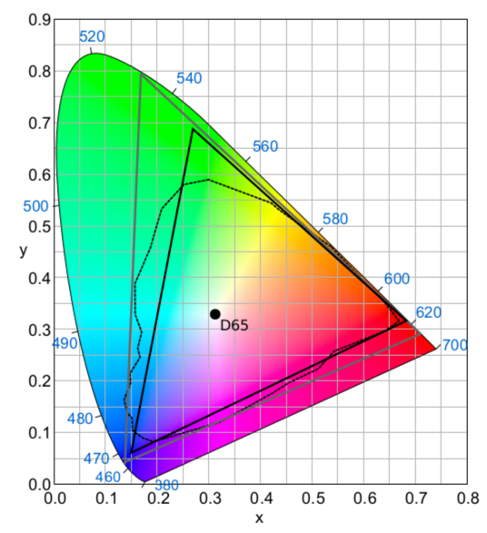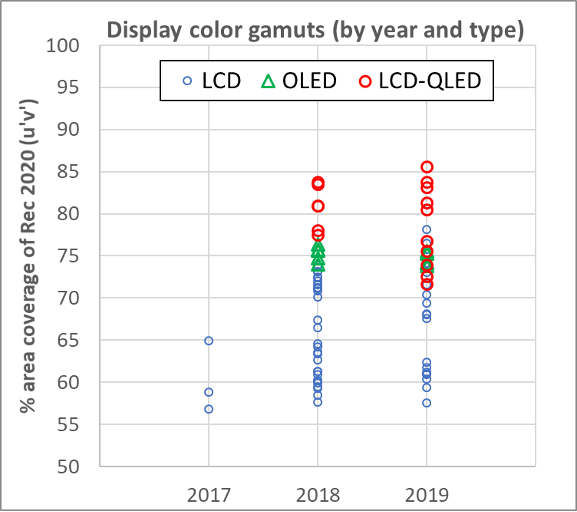A new decade is upon us. It is the year of the Rat. It’s a presidential election year in the US. This decade self-driving cars promise to become ubiquitous. In a mere 7 months the Tokyo 2020 Summer Olympics will commence.
Yet we won’t be watching any of it in Rec2020 color gamut.
There has been a lot of hype around Rec2020 in the past 5 years, and I always questioned if it was achievable or necessary. The standards that govern Rec2020 cover a whole host of specifications, but as a QD and color gamut guru, I’m focused on Rec2020 color gamut for now.
The Rec2020 gamut was defined such that a display that met this specification would be able to reproduce nearly all the colors found in nature (as measured by Pointer in 1980). As you can see in the figure below, this would also include a significant amount of colors that are NOT found in nature. It’s worth noting that current color gamut specifications such as sRGB, 709, even DCI-P3 do not come close to encompassing Pointer’s gamut.


A few interesting trends emerge as I look at this data:
1. Color gamut is increasing every year. This is no surprise, as technology continues to improve. There is very little data for 2017 and earlier however, so it’s difficult to say with confidence how much gamut improves year over year.
2. QLED>OLED>LCD (with some exceptions). QLEDs have the highest gamut, reaching >80% in many cases. OLED TVs are very consistent (no surprise there since LG makes all the panels) at around 75%. LCD TVs are all over the map, ranging from 57-78%, with the majority below 75%.
Why aren’t we there yet?
The photons that we see on a display have been through a lot to get to our eyes, and each of the steps to get there can result in a loss (or increase) in gamut. First, the LED (or OLED) emission spectrum. In a QLED TV this is a blue only LED. For LCD, blue LEDs with phosphors are used to generate all colors, and the spectrum can be quite broad. However it is also possible to use “narrow” band phosphors with an LED, the most extreme example being KSF with multiple narrow emission peaks in the red region. OLED TVs consist of 4 white sub-pixels which must also be filtered. The spectrum of light emitted from the LED or OLED has a major impact on the final gamut we observe. The narrower the emission spectrum, the larger the gamut. In order to achieve Rec2020 we would need to have nearly laser-line width emission from the source. Something that is not achievable with LEDs, OLEDs, or QDs.
In a QLED the next step is conversion of blue photons to green and red before passing through brightness enhancing films followed by liquid crystals. The conversion to narrow red and green is a key differentiator in QLED displays, which increases brightness while improving gamut. This is why QLEDs lead the pack regarding gamut. In order to achieve Rec 2020 the QD emission spectrum would need to be much more narrow than the current state of the art which is ~35-40 nm for InP QDs. Contrary to LCDs, OLEDs do not have a liquid crystal layer, rather the color is selected by the intensity of the OLED device at each sub-pixel.
The final color-impacting step is the color filter. While this step is absolutely necessary in order to show color graphics, it is also highly imperfect. Display engineers must carefully consider the trade-offs between gamut and brightness in color filter design. Color filters that allow more light through generally result in a smaller gamut. An improved gamut can be achieved easily with color filters that absorb a lot of light; however, the brightness of the display will suffer. For Rec2020 to be realized, we would need to design nearly perfect color filters with no bleed through of undesirable wavelengths. This is far from the case currently, and the trade off with brightness is something most viewers would not tolerate.
Do we need it though?
In my opinion, no. Our mind is quite good at making us think colors exist that aren’t actually there. And I think a TV with near 90% gamut looks amazing (there have been a handful at recent trade shows like SID Display Week and CES). To achieve full Rec2020 would require near laser-narrow lines, and it might not look that good. There are differences in the way each individual person perceives color, so what looks good to one may not to another, which brings up the concept of view metamerism (a topic for another day). And the speckle you see with a laser pointer you may also see if the emission from the display is ultra-narrow. I’ll be quite happy if modern displays plateau around 90% coverage of Rec2020.
Despite the goal of Rec2020 being available by the 2020 Olympics, we will not see the true colors of every flag flying in full Rec2020 gamut. It will still look pretty darn good though. Perhaps we should rename Rec2020 to Rec2030? Or Rec20-never? Just a thought!
Thanks as always for reading!
This article originally appeared on DailyDisplay